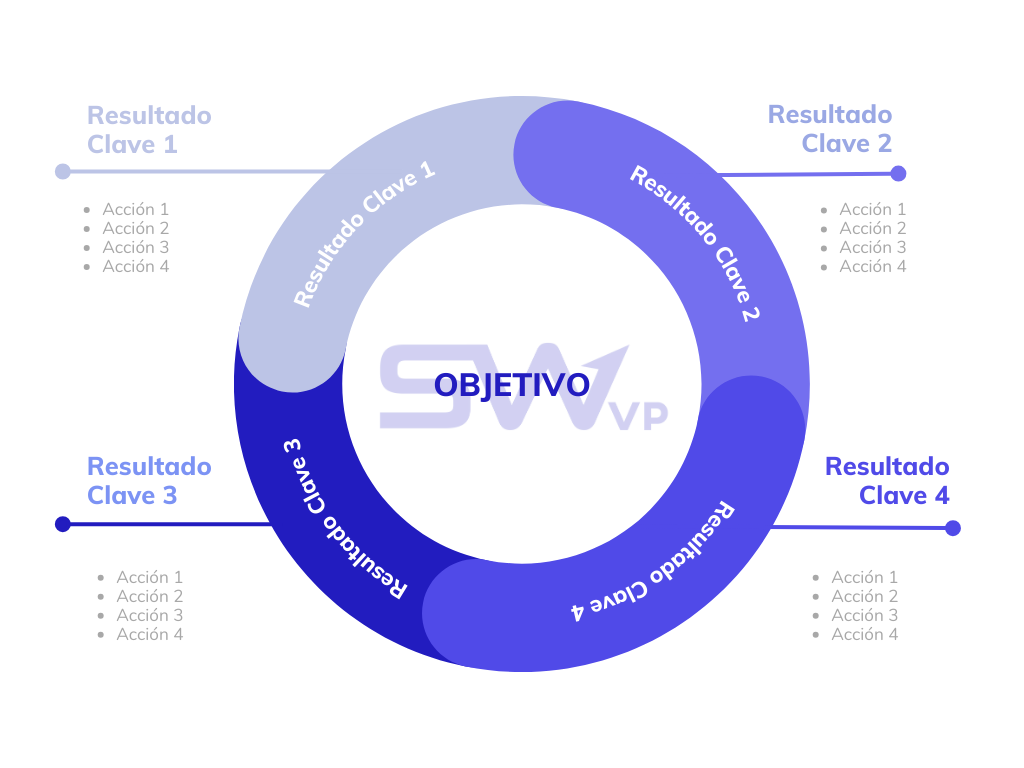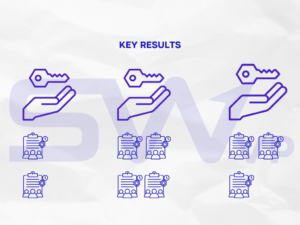
In this article there is a long journey of discovery of OKRs. Here you are going to discover their origins, what they are, benefits how they fit with KPIs and the governance of them.
It is a long article with a lot of information, but all of it very necessary to surely save you some 4-hour course where they fill the time with “straw”, here you will only find the grain.
1-HISTORY OF THE OKR 2-WHAT ARE OKR'S 3-ELEMENTS OF THE OKR'S 4-BENEFITS 5-OKR & KPI 6-SCALING AND GOVERNANCE 8-CONCLUSIONS: START TRAINING YOUR OKR'S
1-HISTORY OF THE OKR

The history of Objectives and Key Results (hereafter OKRs) dates back to the 1950s with Peter Drucker, a modern management guru. In his book “
However, the MBO also had some limitations. Over time, it became clear that the method did not always ensure that the company’s objectives were translated into concrete actions by employees.
In the 1970s, Andy Grove, CEO of Intel, took Drucker’s baton and, inspired by the MBO, Grove developed a more complete system, the OKRs. OKRs combined the definition of ambitious objectives with measurable key results, creating a more robust framework for focusing work and measuring progress.
A key member of the Grove team was John Doerr, who was convinced of the potential of OKRs, and a few years later, as a venture capitalist, introduced them to Google in 1999. According to Doerr, Google founders Larry Page and Sergey Brin were fascinated by the idea of setting their priorities in such a simple way and sharing them openly with the entire company.
Since their implementation at Google, OKRs have become increasingly popular. Today, we find them in leading companies such as Spotify, Slack, Deloitte and Adobe. OKRs are not a magic bullet, but as John Doerr says, quoting Bono, they can “create an environment for risk; for trust; where failure is not a crime punishable by dismissal.create an environment for risk; for trust; where failure is not a crime punishable by dismissal…”.“.
OKRs foster a culture of innovation and continuous learning, which is key to success in today’s business world.
2-WHAT ARE OKR’S
OKRs (Objectives and Key Results) have become an increasingly popular tool for companies looking to drive growth, innovate and achieve excellence. Let’s analyze in detail why they are so effective.
We understand OKRs as an agile framework for critical thinking. Beyond simply being a method for defining goals, OKRs are a

OKRs allow for short planning cycles where leaders’ and teams’ approaches are combined, i.e., top-down. We must understand the objectives as ambitious, so that they drive teams to explore new ways of working and achieve extraordinary results, even if they do not achieve 100%.
OKRs are a powerful and clear synchronization practice that provides transparency and accountability about what you are going to do and what you are committed to. It is an approach to create alignment and commitment around measurable and ambitious objectives. OKRs are established, measured and re-evaluated frequently, allowing teams to make timely adjustments and corrections to stay on track to achieve their goals.
With this methodology, we build a bridge between the vision and mission of an organization and the operational level. By linking daily tasks to quarterly objectives and annual or multi-year objectives, OKRs promote clarity and transparency throughout the company.
3-ELEMENTS OF THE OKR’S
Objectives are at the heart of the OKR methodology. They are simple, qualitative phrases that describe what we want to achieve, i.e., the goal we are working towards. Unlike Key Results, which are quantitative and measurable, Objectives are aspirational and serve as a guide to focus the team’s efforts.

Characteristics of the Objectives:
- Qualitative and aspirational: they are not defined by numbers or metrics, but describe a desired state or outcome in an inspirational way.
- Simple, short and easy to remember: they should be concise and memorable phrases that all team members can understand and repeat without difficulty.
- Independently actionable by the team: each Objective must be specific enough so that the team can identify the actions needed to achieve it without relying on other teams or departments.
- Motivators: they must be ambitious but achievable, inspiring the team to give their best and to work with enthusiasm towards the common goal.
Key Results (KR) are quantitative metrics that allow us to measure progress towards achieving our objectives. They answer the question, “How far or close are we to achieving our goal?” and help us determine if we are on the right track or if we need to make adjustments.

Main characteristics of the KR:
- Quantitative: they must be based on measurable metrics that can be quantified numerically. This allows us to objectively track progress and evaluate the impact of our actions.
- Set of metrics: each objective should have 2 to 5 KRs associated with it. This allows us to have a complete view of progress towards achieving the objective and avoid focusing on a single metric that may not be representative.
- Measuring compliance: must define a starting point (X) and a target (Y). This allows us to measure progress from the starting point to the target and determine whether the KR has been achieved.
- Less is more: in general, it is better to have fewer KRs that are more specific and relevant to the objective. A reduced set of KRs allows us to focus on what really matters and avoid information overload.
- Impact verbs: KRs should use impact-based verbs such as increase, reduce, achieve or maintain. This helps us focus on the desired outcome and avoid vanity metrics that do not measure real progress.
4-BENEFITS
There are many reasons to start implementing OKRs in your company, but here are the ones that stand out the most:
- They strengthen the link between strategy and execution by helping to bridge the gap between long-term strategy and day-to-day activities.
- They promote alignment by creating a feedback loop that ensures that actions are aligned with desired results.
- They reduce unfocused work, forcing teams to question whether their activities really contribute to the achievement of objectives.
- They increase accountability by fostering commitment and transparency among teams.
- They promote commitment among all the people who make up the company as the objectives are defined, written and shared.

5-OKR & KPI
Both KPIs (Key Performance Indicators) and OKRs (Objectives and Key Results) are two widely used management methodologies to establish and measure progress towards strategic objectives. While both pursue the same ultimate goal, they differ in their approach and application.
KPIs emphasize measurement and performance and are characterized by being:
- Fixed in time.
- Provide a snapshot of current performance, i.e., a point in time.
- Based on past data or future goals.
As we have seen, this differs from OKRs in that OKRs advocate alignment, commitment and focus. They are dynamic, transparent, directional and aspirational.
While OKRs and KPIs appear to be disparate approaches, they actually complement each other, with the former providing context and meaning to the latter, framing them within a broader strategic vision. This combination allows:
- Set ambitious and achievable objectives.
- Align all employees around common objectives.
- Measuring progress effectively.
- Adapt to changes in the environment.
- Drive growth and innovation.
In short, OKRs and KPIs are not mutually exclusive tools, but rather two pieces of the same puzzle. By using them together, organizations can create a robust and effective performance management system that will propel them to success.
6-SCALING AND GOVERNANCE
Scaling OKRs effectively requires a systematic, organization-wide approach. A tiered approach can be very useful:
- Company level:
- Establish ambitious OKRs aligned with the company’s mission and vision.
- Clearly communicate OKRs to all employees.
- Link company OKRs to team and department OKRs.
- Equipment level:
- Develop specific and measurable OKRs for each team.
- Ensure that the team’s OKRs are aligned with the company’s OKRs.
- Empower teams to have ownership of their OKRs.
- Individual level:
- Establish individual OKRs that contribute to team objectives.
- Align individual OKRs with company values and priorities.
- Provide employees with the support and resources needed to achieve their OKRs.
Effective governance is crucial to ensure that implementation runs smoothly and that the desired results are achieved. Some key elements are:
- Establish clear roles and responsibilities.
- Define a regular review and evaluation process.
- Provide training and support to employees.
- Use technological tools to facilitate OKR management.
- Foster a culture of transparency and open communication.
By effectively scaling and governing OKRs, organizations can:
- Align all employees around common objectives.
- Improve communication and collaboration.
- Increase responsibility and commitment.
- Drive innovation and growth.
- Achieve a positive and lasting impact.
Ultimately, OKRs, when properly implemented and managed, can be a powerful tool for organizations to translate their strategy into action and achieve significant impact on a large scale.
7-CONCLUSIONS: START TRAINING YOUR OKR’S
OKRs have become a popular tool for companies looking to improve their performance and achieve their objectives. If you are thinking about implementing OKRs in your company, I recommend that you start by defining your strategic objectives and then work with your teams to develop specific, measurable OKRs that will help you achieve those objectives.
Remember that OKRs are not a magic formula, but they can be a valuable tool to help you propel your business to success. If you don’t know how to get started, please contact us.




